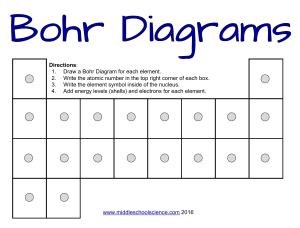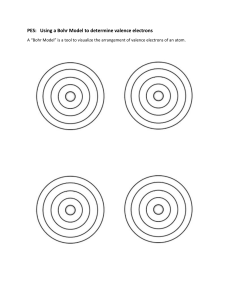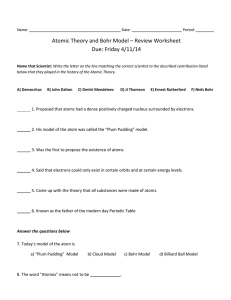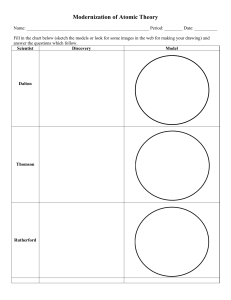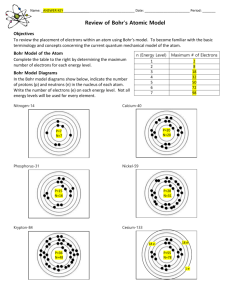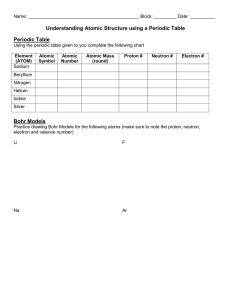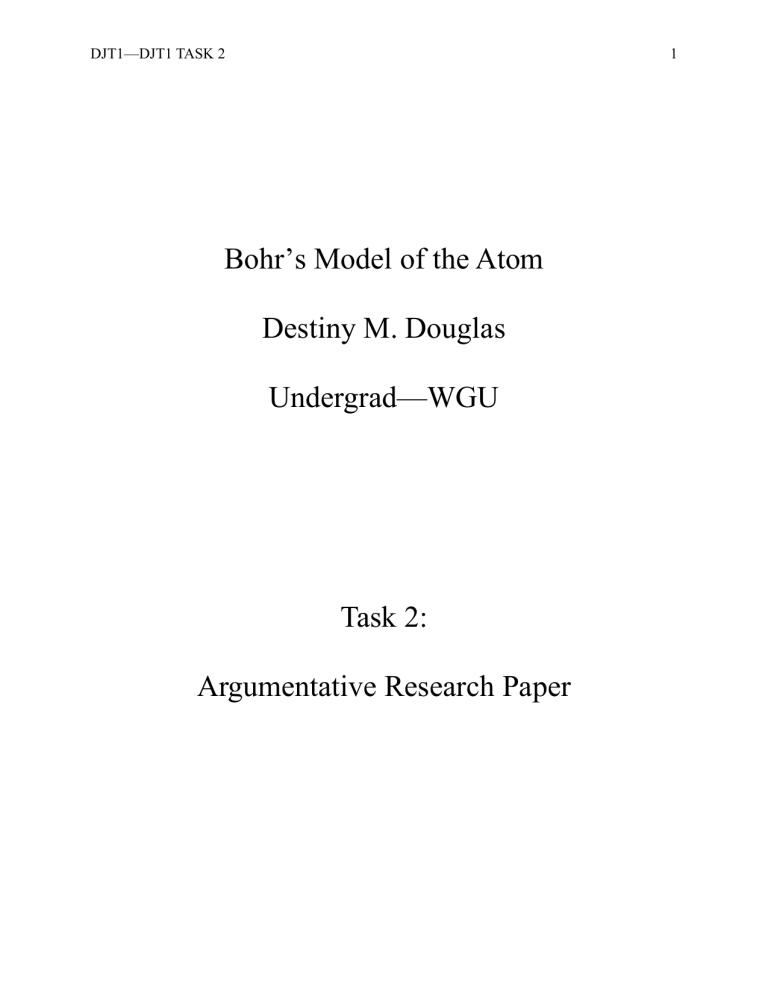
DJT1—DJT1 TASK 2 1 Bohr’s Model of the Atom Destiny M. Douglas Undergrad—WGU Task 2: Argumentative Research Paper DJT1—DJT1 TASK 2 2 Abstract The atomic model theory presented by Niels Bohr is an incorrect and outdated model of the atomic theory and will be thoroughly discussed throughout this paper in accordance with the idea that it should not be taught within the school system as part of the curriculum and has no place in secondary education as an inaccurate representation. Bohr’s model was first introduced in 1915 and was scrutinized under heavy eyes due to the inaccuracy even when first introduced for failed specifications and DJT1—DJT1 TASK 2 3 explanations about multiple components of the theory. The model was later proven to be completely inadequate when the leap was made from classical physics to quantum physics, which will be discussed in further detail later in this work. The model therefore should not be included in the introduction of the atomic model theory within the educational department of high schools. Keywords: Atomic model theory, Bohr’s model, atom, education DJT1—DJT1 TASK 2 4 Bohr’s Model of the Atom All students learn the atomic model at some point in their academic career, but why are they taught the incorrect model? Furthermore, why is the incorrect model of the atom at a higher popularity than the current accurate model? Let us focus on four of the main reasons that this model should not be presented to students before the accurate model is presented: the model is severely outdated considering modern scientific advancements, it violates the Heisenberg Uncertainty Principle that has been proven time and time again, it narrows the ability to model elements to virtually only Hydrogen, and the DJT1—DJT1 TASK 2 5 model cannot explain its relationship to Classical Electrodynamics in regards to radiating electrons. So why is an inaccurate model being recognized in schools as a valid, up-to-date model? Let’s jump into that. The Uncertainty Principle So first talking about the Uncertainty Principle, which states that it is beyond bounds of possibility to know some properties exactly, such as energy, position, time, and momentum at a quantum level. This principle describes these limitations in terms of quantum physics, stating that electrons and photons behave more DJT1—DJT1 TASK 2 6 like waves. Bohr’s model of the atom is built on definitive values. Quantum physics is unlike this due to the differing behavior of electrons. According to quantum mechanics and the uncertainty principle, “…the more precisely the position (momentum) of a particle is given, the less precisely can one say what its momentum (position) is” given by Uffink and Hilgevoors in 2001. Bohr’s model of the atom violates this principle because it assumes both fixed orbitals (position) and trajectories (momentum). While this model was a great steppingstone from DJT1—DJT1 TASK 2 7 transitioning to a greater understanding of the physical world, Bohr’s model is no longer accurate, yet is still being taught to secondary chemistry and physics students without specification on why or how Bohr’s model is inaccurate. It would be of more sense to teach high school students an accurate principle and an up-to-date model of the atom versus a wrongfully proven model of the atom that is recognized by students more frequently than the current model of the atom. DJT1—DJT1 TASK 2 8 Heavier Atoms Getting into heavier atoms, Electron shells were included in Bohr’s version of the atomic model, stating that these shells show different energy levels based on the number of electrons in a singular atom as shown in the model on screen. Bohr also stated in his version of the atomic model that “…one and only one spectral line can be created from an electron between any two energy levels” (Limitations). This was a false point made in the model due to“Such emission spectra were observed for DJT1—DJT1 TASK 2 9 many other elements in the late 19th century, which presented a major challenge because classical physics was unable to explain them” (Line Spectra and the Bohr Model, 2021). Bohr’s atomic model was based on knowledge that classical physics could describe but when an explanation was discovered for this type of emission spectra, Bohr’s model became obsolete with heavier atoms. Later in the article it was described that not only did these equations showed multiple spectra for the Hydrogen atom, which Bohr’s model described as only being DJT1—DJT1 TASK 2 10 able to emit one spectral line. In relation to Bohr’s model, Hydrogen would only have one electron shell as it only has one electron in the atom; however, the atom contains two emissions, one in ultraviolet, and one in infrared. This discovery proved completely that Bohr’s model of the atom was incorrect in accordance with his original statement shown above that there could only be one spectral line between two electron shells. Though this model is inapplicable to heavier atoms and has even been proved inaccurate for the original DJT1—DJT1 TASK 2 11 statement of the only atom that was applicable, the model is still the main one used to introduce the atomic model to students in high schools. To ensure successful learning of the atomic model, the model presented needs to be accurate for ALL elements. Bohr’s model fails to do so but is still taught in schools only for the simplicity of the model and therefore has no place in the introduction of the atomic model in classrooms for high school students. DJT1—DJT1 TASK 2 12 Radiating Electrons In radiating electrons, Bohr’s model was contradictory because he described those electrons moving in fixed orbitals with fixed energy levels. He also explained that electrons radiate when in an excited state and jump to the next energy level, which contradicted his earlier statement of fixed energy levels and would be confusing to a fresh learner of atoms. The Larmor formula shows “…the hydrogen atom, consisting of an electron revolving round a heavy positively charged nucleus, would radiate DJT1—DJT1 TASK 2 13 energy as it accelerates…” (Abdullahi). The Larmor formula correlated with the idea Bohr presented, but when electrons revolve around a nucleus, they radiate due to the energy of them orbiting the nucleus. He upon introduction that electrons would radiate photons in accordance with these orbitals. Bohr could never quantitively explain this idea with any equations to prove the logic of this model. Another adaptation of the point made by Bohr in the introduction of this model is presented by Hasmi in 2021, stating “…electrons present in DJT1—DJT1 TASK 2 14 the specific and particular orbit can never emit or absorb energy…”. This presents the contradictory nature of Bohr’s theory in which he makes the statement that electrons never have the capability to absorb radiation. Bohr’s statements of radiating electrons touch on, but avoid specifications of a logical explanation of the math in this atomic theory, which is another aspect that the current atomic model explains in full including the logic and math behind radiating electrons and how they behave. The atomic theory presented by Bohr makes for a DJT1—DJT1 TASK 2 15 confusing lesson for students who have questions about the logic behind the ideas of this atomic model as it is the theory taught to high school students. Just another reason that the atomic theory presented by Niels Bohr is not a viable candidate for education in the classroom to students learning about atoms. Transition From Classical to Quantum Mechanics Taking the leap from Classical Mechanics to Quantum Mechanics changed a lot of former ideas upon adoption. Quantum mechanics DJT1—DJT1 TASK 2 16 provides a deeper understanding of the components of the atom. Moving to quantum physics had a large impact on the accepted model of the atom, which at the time was Bohr’s model. The points made at the time were impossible to describe using only the equations established by classical physics (Quantum Mechanics and Atomic Orbitals, 2021). To fix this, quantum mechanics introduced wave patterns found in movement of the electron. The quantum model of the atom introduced these changes to physics equations. Bohr’s model was DJT1—DJT1 TASK 2 17 discarded and became classified as outdated. Still though, Bohr’s version of the atomic model is still actively being taught to students instead of the newest model. This should not be the case considering quantum physics was introduced over seventy years ago. Even given that there were significant advancements made in science, Bohr’s version of the atomic model is still taught in schools only for the simplicity of the model instead of teaching the correct model. If students were introduced first to the quantum model, then students would have a greater DJT1—DJT1 TASK 2 18 understanding of the physical world as opposed to a science that no longer applies. To Reiterate everything presented, Bohr’s Atomic Model has been disproven for decades, yet it still the essential go-to for educational purposes in regards to secondary science education. The information depicted by the model was ineffective in explaining an accurate model by means of being outdated, unable to explain radiating electrons, could not be applied to heavy atoms, and fails to coincide with the Heisenberg Principle. It has been proven to only still be taught in classrooms because of its simplicity, however that is simply not how DJT1—DJT1 TASK 2 science works in the sense that the field of science constantly makes new discoveries and alters what is already known to account for new discoveries. So to leave with this: Why are we allowing false information to be taught to our children, the future generation? 19 DJT1—DJT1 TASK 2 20 References Jasrotia, Vikas. (2020). Bohr's Model and Heisenberg's Uncertainty Principle. Science Motive. Retrieved January 20, 2022. Bohr's Model & Heisenberg’s Uncertainty Principle - ScienceMotive. Ling, S. J., Sanny, J., Moebs, W. (2019). The Heisenberg Uncertainty Principle. University Physics Volume 3. Retrieved January 20, 2022. . The Heisenberg Uncertainty Principle – University Physics Volume 3 (opentextbc.ca). DJT1—DJT1 TASK 2 21 Hilgevoors, Jan and Jos Uffink. (Revised 2016). The Uncertainty Principle. Stanford Encyclopedia of Philosophy. Retrieved January 20, 2022. The Uncertainty Principle (Stanford Encyclopedia of Philosophy) Lumen Learning. The Bohr Model. Chemistry Fundamentals. Retrieved January 20, 2022. 3.3 The Bohr Model – Chemistry Fundamentals (ucf.edu) Rioux, Frank. Bohr Model Calculations for Atoms and Ions. Department of Chemistry. DJT1—DJT1 TASK 2 22 Retrieved January 20, 2022. Mathcad BohrAtomsTCE.xmcd (csbsju.edu) Bohr, Neils. (1913). On the Constitution of Atoms and Molecules, Part I. (PDF). Philosophical Magazine. Retrieved January 24, 2022. I. On the constitution of atoms and molecules: The London, Edinburgh, and Dublin Philosophical Magazine and Journal of Science: Vol 26, No 151 (tandfonline.com) Hashmi, Muhammad Aown. (2021). Bohr’s Radius; Bohr’s Atomic Theory. UO Chemists. DJT1—DJT1 TASK 2 23 Retrieved January 24, 2022. Bohr’s Radius | Bohr’s Atomic Theory | UO Chemists Abdullahi, Musa D. (2013). Motion of An Electron In Classical and Relativistic Electrodynamics and An Alternative Electrodynamics. The General Science Journal. Retrieved January 24, 2022. 3 systems of electrod GSJ (gsjournal.net) Quantum Mechanics and Atomic Orbitals. (November 7, 2021). LibreTexts. Retrieved January DJT1—DJT1 TASK 2 24, 2022. 6.5: Quantum Mechanics and Atomic Orbitals - Chemistry LibreTexts. Limitations of Bohr Model: Definition, Properties, and Examples. ResearchTweet. Retrieved January 24, 2022. Limitations of Bohr Model: Definition, Properties, Examples (researchtweet.com) 24
